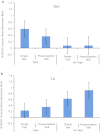Effects of patellar taping on brain activity during knee joint proprioception tests using functional magnetic resonance imaging
- PMID: 22282771
- PMCID: PMC3367140
- DOI: 10.2522/ptj.20110209
Effects of patellar taping on brain activity during knee joint proprioception tests using functional magnetic resonance imaging
Abstract
Background: Patellar taping is a common treatment modality for physical therapists managing patellofemoral pain. However, the mechanisms of action remain unclear, with much debate as to whether its efficacy is due to a change in patellar alignment or an alteration in sensory input.
Objective: The purpose of this study was to investigate the sensory input hypothesis using functional magnetic resonance imaging when taping was applied to the knee joint during a proprioception task.
Design: This was an observational study with patellar taping intervention.
Methods: Eight male volunteers who were healthy and right-leg dominant participated in a motor block design study. Each participant performed 2 right knee extension repetitive movement tasks: one simple and one proprioceptive. These tasks were performed with and without patellar taping and were auditorally paced for 400 seconds at 72 beats/min (1.2 Hz).
Results: The proprioception task without patellar taping caused a positive blood oxygenation level-dependant (BOLD) response bilaterally in the medial supplementary motor area, the cingulate motor area, the basal ganglion, and the thalamus and medial primary sensory motor cortex. For the proprioception task with patellar taping, there was a decreased BOLD response in these regions. In the lateral primary sensory cortex, there was a negative BOLD response with less activity for the proprioception task with taping. Limitations This study may have been limited by the small sample size, a possible learning effect due to a nonrandom order of tasks, and use of a single-joint knee extension task.
Conclusions: This study demonstrated that patellar taping modulates brain activity in several areas of the brain during a proprioception knee movement task.
Figures





References
-
- McConnell J. The management of chondromalacia patellae: a long-term solution. Aust J Physiother. 1986;32:215–223 - PubMed
-
- Bockrath K, Wooden C, Worrell TW, et al. Effects of patellar taping on patellar position and perceived pain. Med Sci Sport Exerc. 1993;25:989–992 - PubMed
-
- Gigante A, Pasquinelli FM, Paladini P, et al. The effects of patellar taping on patellofemoral congruence. Am J Sports Med. 2001;29:88–92 - PubMed
-
- Pfeiffer RP, DeBeliso M, Shea KG, et al. Kinematic MRI assessment of McConnell taping before and after exercise. Am J Sports Med. 2004;32:621–628 - PubMed
Publication types
MeSH terms
Grants and funding
LinkOut - more resources
Full Text Sources
Medical

